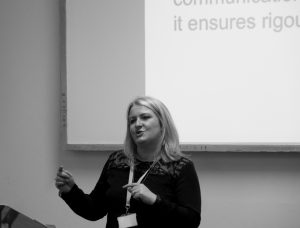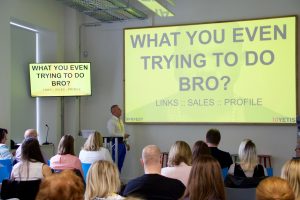Last week, 120 practitioners from across the UK attended #PRFest at Whitespace in Edinburgh, sponsored by PRCA.
Instead of doing an e-book, we’ll be doing round-up posts from each day.
Introduction
 Laura Sutherland, #PRFest Founder and Chief at Aura, welcomed attendees to the second PR festival and thanked sponsors PRCA, venue partner Whitespace, PR students, Hannah, Karen, Jasmine and Sophie and went on to reveal the findings of the pre-event questionnaire.
Laura Sutherland, #PRFest Founder and Chief at Aura, welcomed attendees to the second PR festival and thanked sponsors PRCA, venue partner Whitespace, PR students, Hannah, Karen, Jasmine and Sophie and went on to reveal the findings of the pre-event questionnaire.
No.1 priority for learning:
- Measurement & evaluation
- Social / digital
- Planning and insights
- Crisis comms
- SEO
- Business development
- Business management
Sutherland talked about the importance of measurement and evaluation, as it’s the single biggest way we can demonstrate a return of investment to clients and demonstrate the impact our work has made.
Noting a new priority to the list, business development and business management, public relations as it advances and as we relate our work to business objectives, now sees the need to learn more about business. To develop our own and that of our clients.
Biggest thing for PR to succeed at integrating within biz/org:
- Maintain credibility
- Demonstrate then prove value / ROI
- Present on boards
- Become essential
- Educate ‘business’
- Lead the way with essential skills
- Demonstrate leadership
- Work collaboratively
- As fully involved, as early as possible
- Make resources available for businesses to constantly keep learning about PR
Sutherland said we couldn’t disagree with any of these points. It all links back to public relations asserting its value to businesses and organisations, no matter what role we have.
These two questions and their answers really highlighted how the programme had been developed. We will cover each of these areas through the two days and we should have discussions, debates and participate as much as possible, to get as much out of our time together.
It was also a day for an announcement as Sutherland went on to launch a new collective of independent PR practitioners in Scotland, the Scottish PR Collective. The collective, also an initiative by Laura, has developed a website which makes it easier than ever to choose the perfect PR partner by searching for the desired skills or areas of work. With the rising demand of an independent practitioner and with top quality practitioners in Scotland, this is the first step of turning the agency on its head and pushing for a partnership and direct-working approach.
#1 A Whistle-Stop Tour of Influencer Relations
#PRFest 2017 kicked off proceedings with an engaging and insightful glimpse into influencer relations courtesy of 10 Yetis’ founder Andy Barr. Immediately establishing his charismatic presenting through fun and high-energy interaction, with some highly entertaining results!
Now, let’s get stuck into the PR conversation. An overload of stats is available to us everywhere, which only equates to one thing… plenty of noise about influencer marketing! The main focus of today’s discussion however was Instagram. Why? Instagram are many clients top priority at the moment, with 87% of 300 influencers targeting Instagram according to Hashoff Survey.
 Step One
Step One
What can we all do to incorporate influencer relations successfully into future PR strategies? Here marks the importance of clarifying expectations with the client at the start, also the question of ownership and most significant of all, the need for a senior level buy-in at director level. The key question to ask yourselves is what you are trying to achieve with your campaign, be that links, direct sales or profile increases – it all affects who will be the right influencers for your client.
Step Two
Next stop, idea finding – use ‘BuzzSumo’ as an important analytical tool (more of this to follow from Day 2 talks), which is a handy content discovery tool. But you need to carefully ask whose content is it? Returning back to the question of ownership makes it clear you must establish whose content it is you will be sharing. Will it be your own (riskier) or your influencer’s content?
Step Three
Professionals must get to grips with goal tracking, a simple fix when utilising Google analytics, but there is also Bit.ly and UTM Tracking alternatives for a bit of tracking variety. Final stop is finding those influencers. It’s time to get tech savvy and utilise those apps readily at your disposal. Tribe, a tracking app, indicates more accurately the amount your influencers should be paid – although there is no right answer for this.
10 YETIS’ TOP TIP
Get these two handy phrases ready “Emerging” and “Micro Influencer”
Confused? Read on for Andy’s fun explanation…
How to avoid Fake Influencer Marketing
Cut out the BS. There we said it, well Andy did. Using sites such as Status People helps to spot those influencer fakers by checking accurate social media engagement data to see who’s fake and who’s not. Keep an eye out for red flags, including engagement rates and a subset of account followers. Admittedly, on Instagram this is harder to spot. Note: average engagement rates (comments + Likes / no. of followers) are between 2-6%.
At this point a quick game of higher or lower revealed certain celebrity or high profile accounts actually constituted lower engagement rates than less high-profile figures. This is where micro-influencers come into play, by creating stronger engagement rates than those occupying bigger follower bases. Using micro-influencers also means it’s easier to own the process and enables cooler brands to gift rather than pay for posts.
Utilise your existing PR skills
Be clear about what you want regarding X posts or X tweets, make sure these key objectives are ironed out clearly in the contract. PR people are the best for influencer outreach, but just remember persistence is key (despite potential illusiveness) – so be sure to maintain those influencer relationships months in advance, just like your ever-evolving media relationships. Share your results with your influences, keep in touch, then ‘rinse and repeat’.
#2 Diversity in Public Relations
The diversity panel, put together by Taylor Bennett Foundation and Chaired by Sarah Hall, discussed and made the business case for diversity and inclusion in the PR industry.
 Women in PR
Women in PR
Mary Whenman, President of Women in PR, has dedicated much of time over the last two years creating a successful networking organisation for senior PR women. The aim to increase female presence at boardroom levels, close the gender pay gap (latest figures state a shocking 9k difference) and encourage flexible working hours, led to a thought-provoking panel discussion.
A current unconscious bias exists surrounding these issues and panel members highlighted the necessity to move the conversation on from these issues.
Race & Gender in PR
Ariatu PR’s Ronke Lawal was also on the panel to share her race and gender experiences. Her motivational input emphasised wanting to set your own goals and your own glass ceiling in the face of such diversity issues. Young people are looking for familiar faces everywhere and it is important to ensure the PR industry steps up in this critical area.
Also joined by panelist Anne Groves, a key member of the Taylor Bennett Foundation, where the great work of the foundation for BAME graduates is strongly advocated. For those unaware of their great work, the aim of TBF is to help graduates enter the industry, develop career skills and ultimately change the face of the PR industry, as we know it.
LGBT in PR
PRCA LGBT group Chair, Ethan Spibey, revealed some powerful and shocking statistics. 1 in 4 of PR employees experience bullying, whilst transgender employee experiences are exponentially worse.
However, we loved the positivity from Spibey, who made it clear that inclusion and diversity are opportunities to retain and attract the best talent within and to our industry. After all, it’s up to us to promote ourselves a bit better and turn this into an opportunity to also influence our clients.
#3 Influencer Campaign Workflow
 Our final session of the morning was led by Stephen Waddington, Partner and Chief Engagement Officer at Ketchum, who created a real sense of audience engagement and collaboration by encouraging shared experiences to create the ultimate ‘Post-It Note workflow’ for campaigns.
Our final session of the morning was led by Stephen Waddington, Partner and Chief Engagement Officer at Ketchum, who created a real sense of audience engagement and collaboration by encouraging shared experiences to create the ultimate ‘Post-It Note workflow’ for campaigns.
Stephen proceeded to focus on one topical theme in particular – influencer relations, following on nicely from Andy’s presentation earlier in the morning.
Influencer Relations and Engaging Communities
Where can influencer relations be used to engage communities? Great question. The answers came flooding in from attendees, including brand, newsletter databases, local authority planning permission, wider political campaigns, healthcare, fundraising and internal communications. Basically, anywhere that engages activism.
Anne Groves from Taylor Bennett Foundation cited a £50,000 fundraising campaign as one of her immediate projects, so we worked together to create a workflow which Anne could follow and action.
How do you plan a campaign?
Begin by looking at customer journeys, by using tools to create a search and select process within communities. Quick examples of network mapping tools include social media Tracker, Netbase and Brandwatch.
Finally, find the objective – do so by breaking down public engagement into various constituencies such as universities, progressive corporates, philanthropists and agency heads. Note: a series of niche campaigns will work more effectively with different constituencies.
How do I get your attention?
Video content dominated audience responses to this question. The aim: to make the consumer feel part of the journey and connected in some way. Make your content bold and vibrant by utilising images, design and graphics, whilst also ensuring consistency. The message here was loud and clear; make your content drive your audience enough to care and ultimately donate.
Remember: There must be a value exchange during any influencer campaign.
Stephen Waddington will do a follow-up blog with more detail on the workflow. He’s also a call scheduled with Taylor Bennett Foundation CEO, Sarah Stimson, later this week to discuss the potential to activate the campaign brainstormed during the session.
Blog post drafted by Hannah Smithdale (@PRBee_16), edited by Laura Sutherland and approved by speakers.
